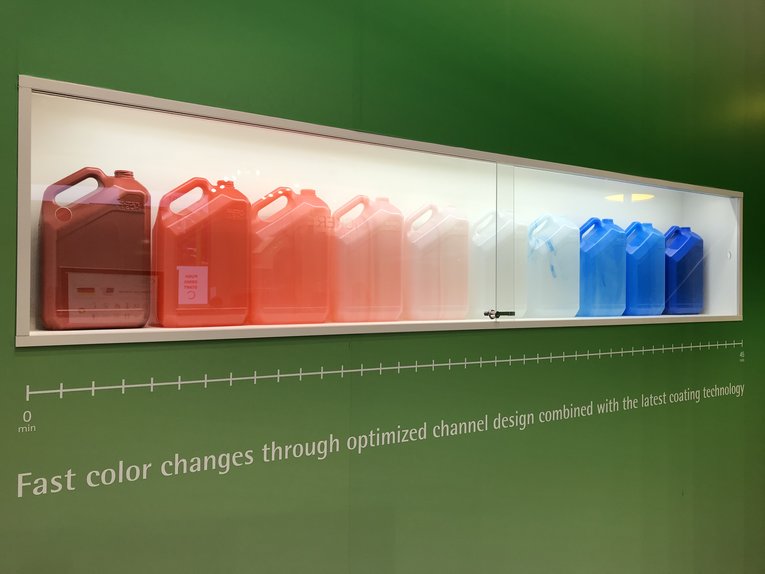New coating substantially accelerates color change
Extrusion blow molding | 09. April 2018

W. MÜLLER, technology leader in the development of customer-specific special solutions for blow molding technology, was able to further reduce the already fast color change times of its popular extrusion die heads.
The lynchpin of the latest innovation from the German special machine manufacturer is the flow channel coatings from the experienced surface finishing expert Dreistegen GmbH, Monschau, Germany. These massively increase the mobility of masterbatch residues on the walls of the plastic-holding channels, which were previously difficult to mobilize, even compared to the already extremely “fast” high-performance blow molding heads from W. MÜLLER.
“Every professional knows that color change times in the blow molding industry are a very critical factor,” ex-
plains Guido Knipp, employee of Troisdorf-based W. MÜLLER GmbH. “In extreme cases, it can take hours for standard extrusion die heads to complete this process. With large products such as large-volume canisters, tons of waste can therefore be produced in un-
favorable cases simply because of the problem of changing colors, and of course this also consumes energy unnecessarily,” says the technician. “This is why we have always taken this critical factor hugely into account in the development of our extrusion heads, for example through highly optimized flow channel design. That’s why our heads have always been in the top group when it comes to color change speed.”
But time does not stand still – the color master batches are also developing. “Unfortunately, this can also have a negative effect on color change times,” says Christian Müller, Technical Director of the German family business W. MÜLLER, and son of the company founder. “As a leading technical supplier of high-performance extrusion heads, we recognize this as something we have a duty to deal with, of course. With our new flow channel coatings, we have actually achieved another quantum leap,” says Christian Müller.
Customized flow channels: Now optimized even further
A detailed look at the processes in the extrusion head shows how the innovative W. MÜLLER approach works. “The speed of the color change strongly depends on the nature of the flow channel walls. For physical reasons, the core of the extrudate always flows faster than its peripheral areas, which are subject to direct friction with the walls,” explains Christian Müller. “This means that it may take some time for the last traces of the old masterbatch to be rinsed out of the head. With a special coating that we developed in close cooperation with Dreistegen GmbH in Monschau we were able to spark another booster even for W. MÜLLER’s standards: it reduces wall friction and thus accelerates color change times.”
The coating is a so-called metal-amorphous functional layer which is applied to the surface of the flow channels in a complex physical process of the plastic-carrying components. This causes the plastic to flow in a laminar fashion all the way to the edge areas. The more flow-friendly surface means that existing pigment or viscous masterbatch
residues can now be rinsed out a good deal faster than before. Customers who need to make frequent color changes can therefore benefit greatly from this additional option. Of course, the choice of masterbatches and other conditions must also be correct. “Of course, real savings for the customer can differ, as they depend heavily on the pigments used,” says Christian Müller. “But the results speak for themselves. And we examined a double head: with larger systems, the material savings are naturally even greater.”